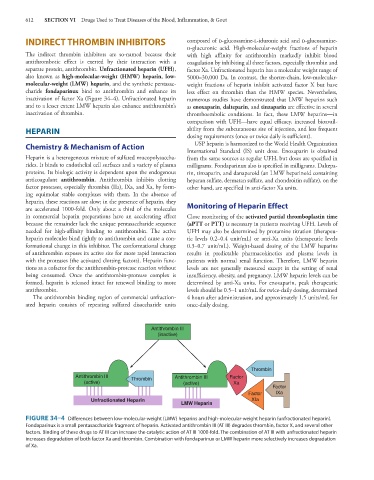Page 626 - Basic _ Clinical Pharmacology ( PDFDrive )
P. 626
612 SECTION VI Drugs Used to Treat Diseases of the Blood, Inflammation, & Gout
INDIRECT THROMBIN INHIBITORS composed of d-glucosamine-l-iduronic acid and d-glucosamine-
d-glucuronic acid. High-molecular-weight fractions of heparin
The indirect thrombin inhibitors are so-named because their with high affinity for antithrombin markedly inhibit blood
antithrombotic effect is exerted by their interaction with a coagulation by inhibiting all three factors, especially thrombin and
separate protein, antithrombin. Unfractionated heparin (UFH), factor Xa. Unfractionated heparin has a molecular weight range of
also known as high-molecular-weight (HMW) heparin, low- 5000–30,000 Da. In contrast, the shorter-chain, low-molecular-
molecular-weight (LMW) heparin, and the synthetic pentasac- weight fractions of heparin inhibit activated factor X but have
charide fondaparinux bind to antithrombin and enhance its less effect on thrombin than the HMW species. Nevertheless,
inactivation of factor Xa (Figure 34–4). Unfractionated heparin numerous studies have demonstrated that LMW heparins such
and to a lesser extent LMW heparin also enhance antithrombin’s as enoxaparin, dalteparin, and tinzaparin are effective in several
inactivation of thrombin. thromboembolic conditions. In fact, these LMW heparins—in
comparison with UFH—have equal efficacy, increased bioavail-
HEPARIN ability from the subcutaneous site of injection, and less frequent
dosing requirements (once or twice daily is sufficient).
Chemistry & Mechanism of Action USP heparin is harmonized to the World Health Organization
International Standard (IS) unit dose. Enoxaparin is obtained
Heparin is a heterogeneous mixture of sulfated mucopolysaccha- from the same sources as regular UFH, but doses are specified in
rides. It binds to endothelial cell surfaces and a variety of plasma milligrams. Fondaparinux also is specified in milligrams. Daltepa-
proteins. Its biologic activity is dependent upon the endogenous rin, tinzaparin, and danaparoid (an LMW heparinoid containing
anticoagulant antithrombin. Antithrombin inhibits clotting heparan sulfate, dermatan sulfate, and chondroitin sulfate), on the
factor proteases, especially thrombin (IIa), IXa, and Xa, by form- other hand, are specified in anti-factor Xa units.
ing equimolar stable complexes with them. In the absence of
heparin, these reactions are slow; in the presence of heparin, they Monitoring of Heparin Effect
are accelerated 1000-fold. Only about a third of the molecules
in commercial heparin preparations have an accelerating effect Close monitoring of the activated partial thromboplastin time
because the remainder lack the unique pentasaccharide sequence (aPTT or PTT) is necessary in patients receiving UFH. Levels of
needed for high-affinity binding to antithrombin. The active UFH may also be determined by protamine titration (therapeu-
heparin molecules bind tightly to antithrombin and cause a con- tic levels 0.2–0.4 unit/mL) or anti-Xa units (therapeutic levels
formational change in this inhibitor. The conformational change 0.3–0.7 unit/mL). Weight-based dosing of the LMW heparins
of antithrombin exposes its active site for more rapid interaction results in predictable pharmacokinetics and plasma levels in
with the proteases (the activated clotting factors). Heparin func- patients with normal renal function. Therefore, LMW heparin
tions as a cofactor for the antithrombin-protease reaction without levels are not generally measured except in the setting of renal
being consumed. Once the antithrombin-protease complex is insufficiency, obesity, and pregnancy. LMW heparin levels can be
formed, heparin is released intact for renewed binding to more determined by anti-Xa units. For enoxaparin, peak therapeutic
antithrombin. levels should be 0.5–1 unit/mL for twice-daily dosing, determined
The antithrombin binding region of commercial unfraction- 4 hours after administration, and approximately 1.5 units/mL for
ated heparin consists of repeating sulfated disaccharide units once-daily dosing.
Antithrombin III
(inactive)
Thrombin
Antithrombin III Thrombin Antithrombin III Factor
(active) (active) Xa
Factor
Factor IXa
Unfractionated Heparin XIa
LMW Heparin
FIGURE 34–4 Differences between low-molecular-weight (LMW) heparins and high-molecular-weight heparin (unfractionated heparin).
Fondaparinux is a small pentasaccharide fragment of heparin. Activated antithrombin III (AT III) degrades thrombin, factor X, and several other
factors. Binding of these drugs to AT III can increase the catalytic action of AT III 1000-fold. The combination of AT III with unfractionated heparin
increases degradation of both factor Xa and thrombin. Combination with fondaparinux or LMW heparin more selectively increases degradation
of Xa.

